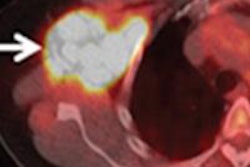While FDG-PET/CT is considered the gold standard for staging and restaging Hodgkin's and non-Hodgkin's lymphoma, "non-Hodgkin's lymphoma subtypes with low FDG uptake have always represented a challenge," study presenter Dr. Chiara Giraudo told AuntMinnie.com. "Here, the additional information provided by MRI, which has a much higher soft-tissue contrast than CT, may clearly improve lesion detection."
Radiation dose to patients is also "problematic," in part because lymphoma patients are "often young and need multiple follow-up examinations over extended time periods," Giraudo added.
The study included approximately 30 patients who received FDG-PET/MRI and FDG-PET/CT scans for Hodgkin's and non-Hodgkin's lymphoma, including mucosa-associated lymphoid tissue lymphoma. FDG-PET/MRI achieved 100% sensitivity and specificity, compared with 80% sensitivity and specificity with FDG-PET/CT.
"PET/MRI is an extraordinary, innovative technique because it combines metabolic information carried by the PET component with the superb, as well as functional, information of MRI," he said.
When Giraudo and colleagues added diffusion-weighted imaging, they found that DWI improved tumor detection for non-FDG-avid lymphomas and provided a second quantitative parameter for treatment response assessment.
"The inclusion of DWI clearly improved staging and restaging of lymphoma patients, relative to FDG-PET/CT," Giraudo said. "This was particularly true in patients with mucosa-associated lymphoid tissue lymphoma, which FDG-PET and CT failed to detect in some cases."
The researchers have recruited additional patients to try to more accurately determine the influence of MRI sequence protocol variations within FDG-PET/MRI.
"Other main research topics of our group in the field of lymphoma imaging include a more accurate assessment of diffuse bone marrow involvement, and the development of biomarkers for early treatment response assessment and prediction of long-term clinical outcome by means of PET/MR," Giraudo said.



















